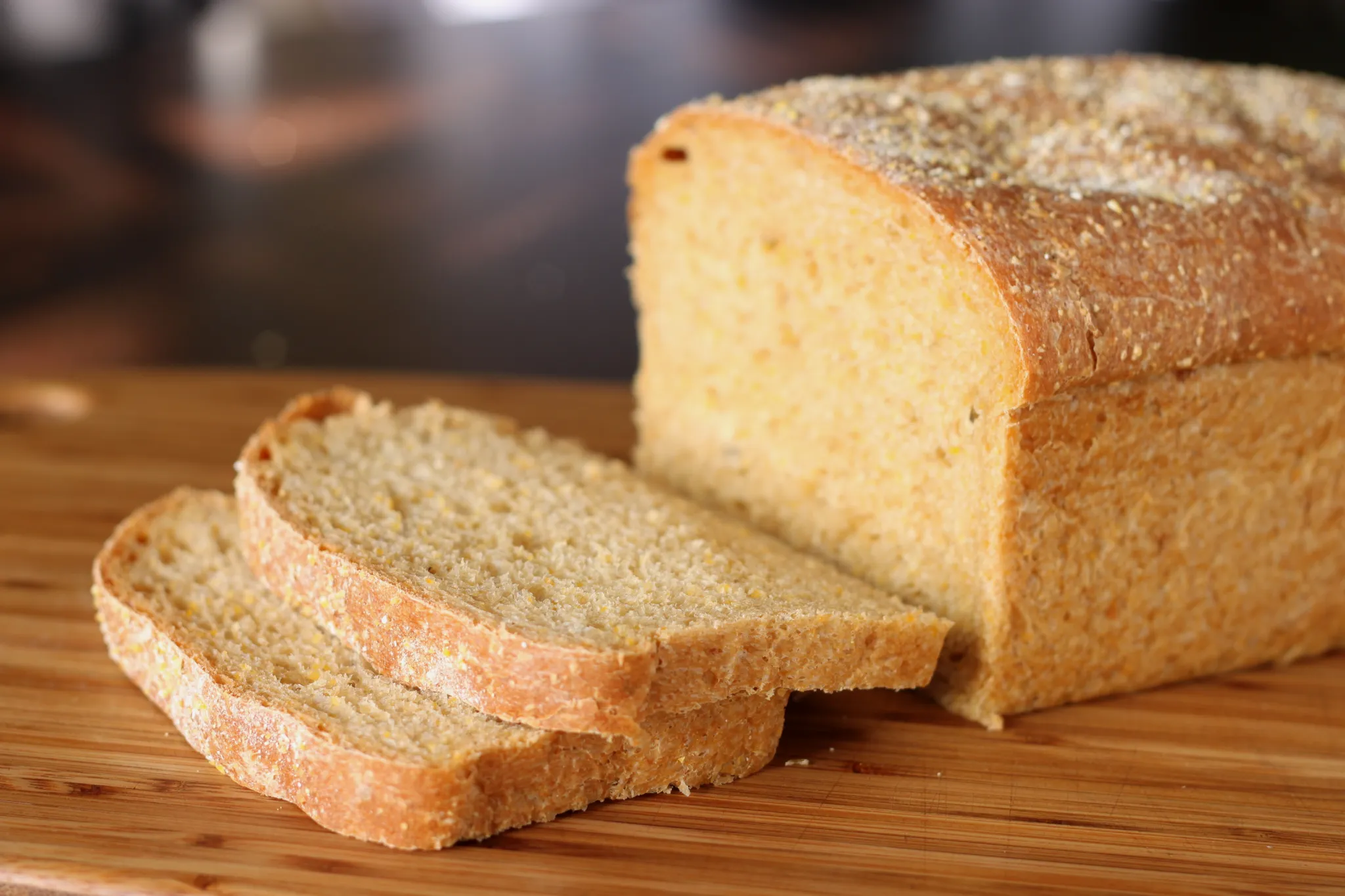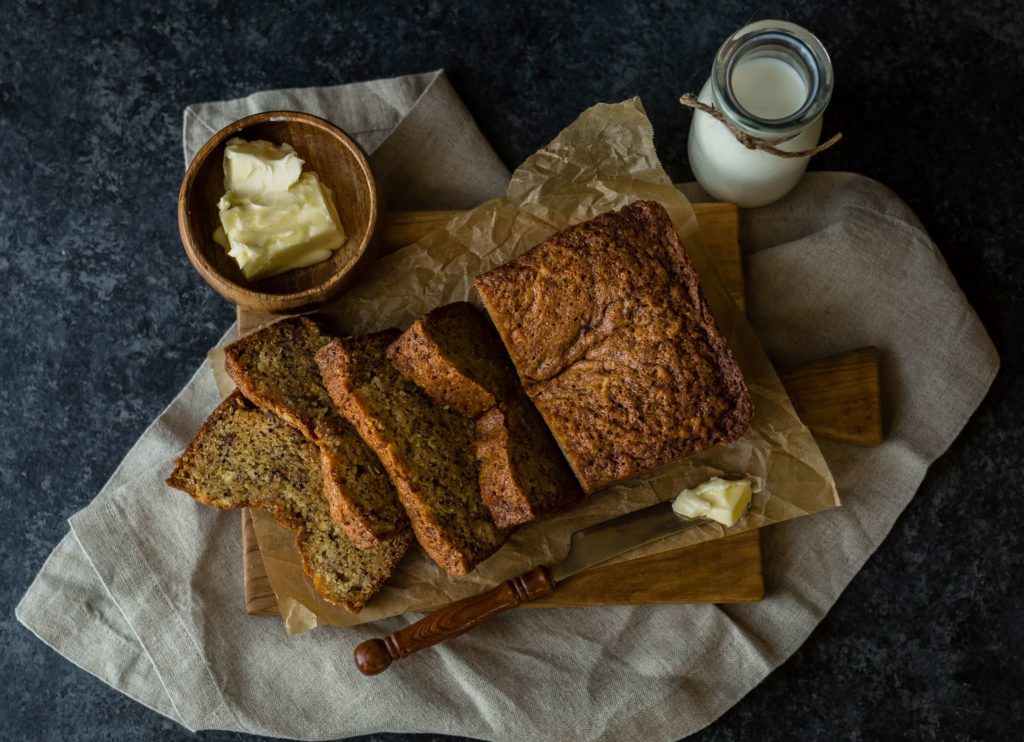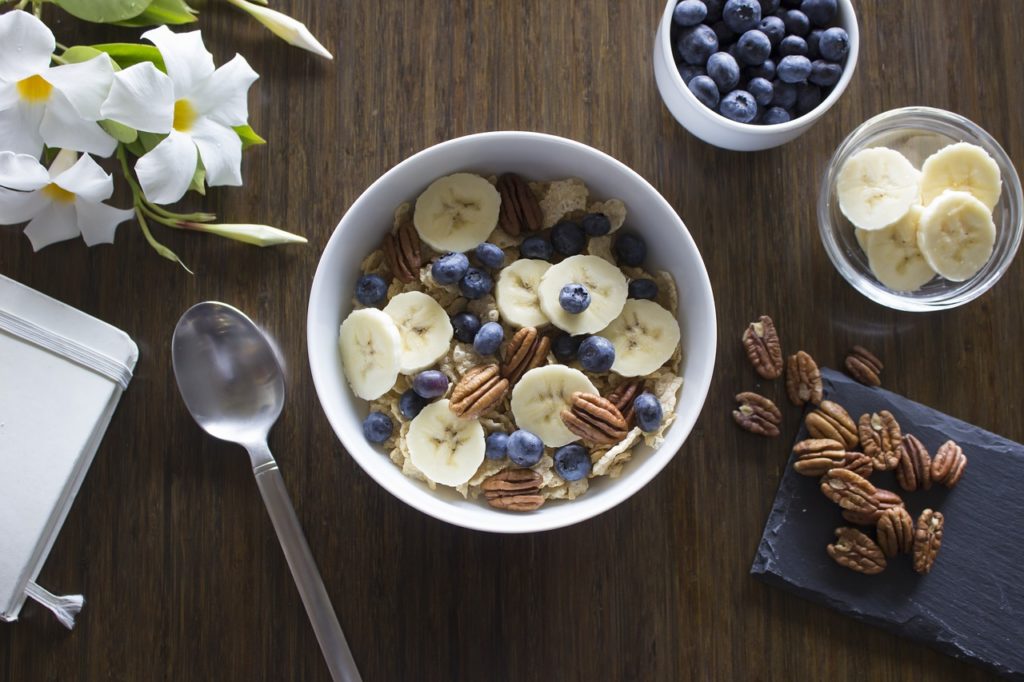
Are you craving a delicious homemade treat? Look no further than this mouthwatering recipe for banana bread using oil. It’s the perfect way to use up those overripe bananas sitting on your kitchen counter. With just a few simple ingredients and easy-to-follow steps, you’ll have a warm and moist loaf of banana bread in no time. So, grab your apron and get ready to bake up a storm!
Banana bread is a classic comfort food that never fails to satisfy. This recipe takes it up a notch by using oil instead of butter, resulting in a lighter and more tender texture. Plus, it’s a great option for those who may be lactose intolerant or looking for a dairy-free alternative. The combination of ripe bananas, aromatic spices, and a hint of vanilla creates a heavenly aroma that will fill your kitchen as the bread bakes. Get ready to impress your family and friends with this delightful treat!
Ingredients

When it comes to making a delicious banana bread using oil, you’ll need a few key ingredients. Here’s what you’ll need to gather before you start baking:
1. Ripe Bananas – The star ingredient of any banana bread recipe is, of course, ripe bananas. Look for bananas that are yellow with brown spots, as these are the sweetest and will give your bread a rich banana flavor.
2. Vegetable Oil – Instead of using butter, this recipe calls for vegetable oil. It not only adds moisture to the bread but also creates a lighter and more tender texture.
3. Granulated Sugar – To sweeten the bread, you’ll need granulated sugar. It balances out the natural tartness of the bananas and adds a touch of sweetness to every bite.
4. Eggs – Eggs play a crucial role in binding the ingredients together and adding structure to the bread. Make sure your eggs are at room temperature for the best results.
5. All-Purpose Flour – For the perfect texture, you’ll need all-purpose flour. It provides the necessary structure and stability to the bread.
6. Baking Soda – Baking soda is the leavening agent in this recipe. It helps the bread rise and gives it a light and fluffy texture.
7. Salt – Just a pinch of salt enhances the flavors and balances the sweetness of the bread.
8. Vanilla Extract – Adding a splash of vanilla extract brings out the natural sweetness of the bananas and adds a delightful aroma to your bread.
Optional Add-Ins

Feel free to get creative and add your own personal touch to the recipe. Here are a few optional add-ins that can take your banana bread to the next level:
- Chopped Nuts – Walnuts or pecans add a delightful crunch and nutty flavor to the bread.
- Chocolate Chips – For all the chocolate lovers out there, adding a handful of chocolate chips will make your banana bread irresistible.
- Cinnamon – A sprinkle of cinnamon adds warmth and depth to the flavor profile of the bread.
Now that you have all the ingredients ready, it’s time to move on to the next step: the preparation process.
Step 1: Preparing the Dry Ingredients
Now that you have gathered all the necessary ingredients, it’s time to start preparing the dry ingredients for your delicious banana bread. This step is crucial as it ensures that your bread has the perfect texture and consistency.
- Start by measuring out 2 cups of all-purpose flour. This will serve as the base for your banana bread and give it a soft and tender crumb.
- Next, add 1 teaspoon of baking soda to the flour. Baking soda is a leavening agent that helps the bread rise and gives it a light and fluffy texture.
- To enhance the flavor of your banana bread, add 1/2 teaspoon of salt. Salt not only adds a savory touch but also helps balance the sweetness of the bananas.
- Now it’s time to add a touch of warmth and aroma to your bread. Sprinkle in 1 teaspoon of ground cinnamon. Cinnamon pairs beautifully with the sweetness of bananas and adds a cozy and comforting flavor.
- Lastly, for an extra layer of depth and richness, add 1/4 teaspoon of nutmeg. Nutmeg has a warm and slightly sweet flavor that complements the bananas perfectly.
Once you have added all the dry ingredients to a mixing bowl, give them a good whisk or stir to ensure they are well combined. This will help distribute the spices evenly throughout the batter and guarantee a burst of flavor in every bite.
Step 2: Mixing the Wet Ingredients
Now that you have your dry ingredients all whisked together, it’s time to move on to the wet ingredients. Mixing the wet ingredients is an important step in creating a moist and flavorful banana bread. So, let’s get started!
In a separate bowl, mash up some ripe bananas. The riper the bananas, the sweeter and more aromatic your banana bread will be. Fun fact: did you know that bananas become sweeter as they ripen due to the conversion of starches into sugars? So don’t be afraid to use those overripe bananas that have been sitting on your counter!

« Master the Art of Baking Moist and Flavorful Banana Bread with This Gold Medal Recipe
The Ultimate Banana Cream Pie Recipe with Pudding and Vanilla Wafers »
Next, add in some granulated sugar and brown sugar to the mashed bananas. The combination of these sugars will add sweetness and depth of flavor to your bread. Using both types of sugar will give your banana bread a richer taste and a lovely golden color.
It’s time to add in the oil. Using oil instead of butter in this recipe creates a lighter and more tender texture, making it a great option for those who are lactose intolerant or looking for a dairy-free alternative. Pour in the oil and vanilla extract into the bowl with the mashed bananas and sugars. The oil will help to keep the bread moist and give it a soft crumb.
To bring all the flavors together, it’s time to whisk in a couple of eggs. The eggs act as a binder, giving your banana bread structure and helping it rise. They also add richness and contribute to the overall moistness of the bread.
Once all the wet ingredients are combined, give it a good mix until everything is well incorporated. You want a smooth and creamy mixture with no lumps of banana or streaks of oil.
Step 3: Combining the Wet and Dry Ingredients
Now that you have prepared the dry ingredients, it’s time to move on to the next step: combining the wet and dry ingredients. This is where the magic happens and your banana bread batter starts to come together!
First, gather all of your wet ingredients. You’ll need mashed bananas, granulated sugar, brown sugar, oil, vanilla extract, and eggs. These ingredients not only add moisture and sweetness to the bread, but also contribute to its rich flavor.
In a separate mixing bowl, whisk together the mashed bananas, granulated sugar, brown sugar, oil, vanilla extract, and eggs. Make sure to mix well until all the ingredients are fully incorporated and you have a smooth and creamy mixture. This will ensure that the flavors are evenly distributed throughout the bread.
Next, it’s time to add the dry ingredients to the wet mixture. Gradually pour the dry ingredients into the bowl of wet ingredients, stirring gently with a wooden spoon or spatula. Be careful not to overmix the batter, as this can result in a dense and tough banana bread. Mix just until the dry ingredients are fully incorporated.
At this point, you may also choose to add any optional add-ins to the batter. Whether it’s chopped nuts, chocolate chips, or a sprinkle of cinnamon, these extras will take your banana bread to the next level of deliciousness. Fold them into the batter gently, ensuring they are evenly distributed.

Once your batter is ready, it’s time to move on to the next step in baking your banana bread. But before we get to that, let’s take a moment to appreciate the aroma that fills the kitchen when the wet and dry ingredients come together. The combination of ripe bananas, aromatic spices, and a hint of vanilla is simply irresistible.
So, with your batter prepared and your add-ins mixed in, you’re one step closer to enjoying a slice of moist and flavorful banana bread. Stay tuned for the next step, where we’ll explore the final stages of baking and getting that perfect golden crust on your bread.
Step 4: Adding the Mashed Bananas
Now that you have mixed together the wet ingredients, it’s time to add the star of the show – the mashed bananas! This is where the magic happens, as the bananas bring a natural sweetness and moistness to the bread. Not to mention, they are packed with nutrients like potassium and vitamin B6, making this banana bread a healthier treat.
To get started, make sure you have some ripe bananas on hand. The riper the bananas, the sweeter they are, and the easier they will mash. Look for bananas that have a few brown spots on the skin – this indicates that they are fully ripe and perfect for baking.
Peel the bananas and place them in a separate bowl. Grab a fork or a potato masher and start mashing them until they become smooth and creamy. You can leave a few small lumps if you prefer some texture in your bread.

Once the bananas are mashed, add them to the bowl with the wet ingredients. Gently stir everything together until well combined. The mashed bananas will infuse the batter with their delicious flavor and create a moist and tender texture.
Remember, it’s important not to overmix the batter at this stage. Overmixing can result in a dense and tough bread. Just stir until the ingredients are evenly distributed, and any streaks of flour are no longer visible.
Step 5: Adding oil and mixing the batter
Now that you have mashed the ripe bananas and combined all the wet ingredients, it’s time to add the oil and mix the batter. This step is crucial in creating a moist and tender texture for your banana bread.
Adding the oil: Instead of using butter, we will be using oil in this recipe. Oil not only adds moisture to the bread but also helps to keep it light and tender. You can use any neutral-flavored oil such as vegetable oil or canola oil. Measure out the required amount of oil and pour it into the bowl with the wet ingredients.
Mixing the batter: Using a whisk or a spatula, gently stir the oil into the wet ingredients until they are well combined. Be careful not to overmix the batter at this stage. Overmixing can lead to a dense and tough banana bread. Aim for a smooth and well-incorporated batter.

If you prefer a more indulgent texture, you can also add some optional add-ins at this point. Consider adding chopped nuts like walnuts or pecans for a crunchy texture. Chocolate chips are another popular choice that adds a delightful touch of sweetness. You can also sprinkle some cinnamon into the batter for a warm and cozy flavor.
Once you have added the oil and mixed in any desired add-ins, your banana bread batter is now ready for baking. Remember to preheat your oven and grease your loaf pan before pouring the batter in.
Stay tuned for the next step, where we will guide you through the baking process and reveal the secret to achieving a perfectly golden and moist banana bread.
Step 6: Preparing the Baking Pan
Now that your banana bread batter is ready, it’s time to prepare the baking pan before pouring in the batter. This step is crucial to ensure that your banana bread bakes evenly and doesn’t stick to the pan.
Here’s what you need to do:
- Grease the pan: Start by greasing the inside of the baking pan. You can use cooking spray, butter, or oil to coat the bottom and sides of the pan. This will prevent the bread from sticking and make it easier to remove once it’s baked.
- Line the pan (optional): If you prefer, you can also line the pan with parchment paper. This will provide an extra layer of protection and make it even easier to remove the bread. Simply cut a piece of parchment paper to fit the bottom of the pan and press it down.
- Flour the pan: After greasing or lining the pan, sprinkle a light dusting of flour all over the greased surface. This will create a non-stick barrier between the batter and the pan, ensuring that the bread comes out easily.
- Tap out excess flour: Once you’ve floured the pan, gently tap it on the countertop to remove any excess flour. This will prevent it from forming a thick layer on the bottom of the bread.

By following these simple steps, you’ll ensure that your banana bread bakes evenly and releases from the pan effortlessly. Now, you’re ready to pour in the batter and get it into the oven for baking.
Remember, the quality of your banana bread depends not only on the ingredients and the recipe but also on the preparation and baking process. Taking the time to properly prepare the baking pan will result in a perfectly baked and delicious banana bread.
Step 7: Baking the Banana Bread
Now that you have prepared the batter for your delicious banana bread, it’s time to bake it to perfection. Follow these steps to ensure a successful baking process:
- Preheat your oven: Before you start baking, preheat your oven to 350°F (175°C). This will ensure that the bread bakes evenly and rises properly.
- Prepare the baking pan: Grease the inside of the pan with cooking spray, butter, or oil. If you want to make it easier to remove the bread from the pan, you can also line it with parchment paper. Remember to tap out any excess flour after sprinkling it on the greased surface to create a non-stick barrier.
- Pour in the batter: Carefully pour the prepared batter into the greased and floured baking pan. Use a spatula to scrape any remaining batter from the bowl to ensure you get every last bit of that deliciousness.
- Bake it to perfection: Place the pan in the preheated oven and bake for approximately 50 to 60 minutes. Keep an eye on the bread as it bakes, as the exact baking time may vary depending on your oven. To check if the bread is done, insert a toothpick or a small knife into the center of the bread. If it comes out clean or with just a few crumbs clinging to it, your banana bread is ready.
- Cool and serve: Once the bread is baked, remove it from the oven and allow it to cool in the pan for about 10 minutes. This will make it easier to remove the bread from the pan without it falling apart. After 10 minutes, transfer the bread to a wire rack to cool completely. Once cooled, slice and serve your homemade banana bread.
Remember, baking times may vary, so keep an eye on your banana bread as it bakes. The aroma of freshly baked banana bread will fill your kitchen, tempting you to take a bite right away. However, it’s important to exercise patience and allow it to cool before indulging in its moist and tender goodness.
Conclusion
Now that you have the recipe for banana bread using oil, you can enjoy a lighter and more tender version of this classic treat. By substituting butter with oil, you not only create a dairy-free alternative but also achieve a moist and flavorful bread. The addition of ripe bananas, aromatic spices, and a hint of vanilla adds a delicious twist to the traditional recipe.

Remember to gently stir the mashed bananas into the wet ingredients to maintain the moist and tender texture of the bread. Avoid overmixing the batter to prevent a dense and tough outcome. Additionally, don’t forget to properly prepare the baking pan by greasing it and dusting it with flour for a non-stick surface.
After baking at 350°F (175°C) for approximately 50 to 60 minutes, allow the bread to cool before slicing and serving. The homemade banana bread is ready to be enjoyed!
So go ahead and give this recipe a try. Your taste buds will thank you for the delightful combination of flavors and the soft, moist texture of this banana bread made with oil. Happy baking!
















